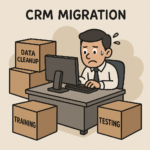CRM Migration: 5 Lessons Nonprofits Keep Ignoring

Every nonprofit dreams of a seamless CRM migration: smooth timelines, clean data, happy users, and immediate ROI. Reality? Too often it’s missed deadlines, frustrated staff, broken integrations, and “temporary” workarounds that live on for years.
The truth is, nonprofits keep repeating the same mistakes. Here are five hard-won lessons that many organizations ignore—at their peril.
1. Underestimating the Data Cleanup is Job #1 for a CRM Migration
Most nonprofits wait until the migration process is underway before addressing the mountain of messy data: duplicates, inconsistent codes, outdated records, and fields that no one has touched in years. By then, it’s too late.
Lesson ignored: Data cleanup isn’t a migration task—it’s a pre-migration project. You need to invest months (not weeks) in data preparation before you even think about mapping or migrating.
2. Believing Technology Alone Will Solve Problems
Too many organizations think a shiny new CRM will fix broken processes, siloed teams, or poor fundraising strategy. It won’t. A CRM only magnifies what already exists—good or bad.
Lesson ignored: Fix your processes and align your teams before flipping the switch. Migration is the worst time to patch over years of internal dysfunction.
3. Neglecting Change Management and Training
Nonprofit staff often get tossed into new systems with little explanation beyond a one-hour webinar. No wonder adoption suffers. People fall back to Excel, or worse, keep shadow databases.
Lesson ignored: Change management is non-negotiable. Involve staff early, communicate why the migration is happening, and provide proper training and support. Otherwise, your “new system” is just expensive shelfware.
4. Skipping UAT (User Acceptance Testing) or Rushing It
Executives want to cut corners on testing because it delays the go-live date. But every skipped test scenario turns into a support ticket—or worse, a loss of donor trust—once the system is live.
Lesson ignored: UAT is your insurance policy. Test every gift entry scenario, every donor journey, and every integration. If it feels tedious, you’re probably doing it right.
5. Forgetting About Post-Go-Live Support
Many nonprofits treat go-live as the finish line. In reality, it’s the starting point. Staff need hand-holding, issues need resolving, and enhancements need planning. Without this, momentum dies fast.
Lesson ignored: Budget for at least 6–12 months of hyper-care. Dedicated support after launch is the difference between thriving in the new CRM and sliding back into chaos.
Nonprofits can’t afford to keep repeating these same errors. A CRM migration is one of the biggest investments your organization will ever make—time, money, and morale are all on the line. Ignore these lessons, and you’ll join the long list of nonprofits that emerge from migration with nothing more than a new system and the same old problems.
Face reality early, plan properly, and treat the migration as both a technical and organisational transformation. That’s how you make the leap worth it.
